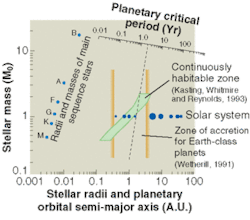Sensors are being shipped and processing has begun on the mirror that will be used in the Kepler Mission, developed at NASA Ames (Moffet Field, CA). The Kepler Mission, a single-instrument spacecraft scheduled to launch in 2007, is named after the German astronomer who described the laws of planetary motion. Its photometer will monitor space looking for orbits of Earth-sized planets and will provide NASA with data that will be used to estimate the planets' sizes, orbital radii, and temperatures.
These parameters are significant in the search for habitability because life, at least as we know it, depends on the presence of liquid water, a fact that also limits the size range for habitability. If a planet is less than half the mass of Earth, it wouldn't have enough mass to hold onto a life-sustaining atmosphere. Too massive a planet—anything above 10 Earth masses—would have so much gravitational pull that it would hold onto even the lightest elements, like hydrogen and helium, creating a thick atmosphere similar to those of Jupiter and Saturn. In addition to the planet's size, its distance from its star is also crucial because that determines its temperature.
Using these parameters, numerical models of planet formation based on molecular-cloud collapse were combined with other calculations to predict a small continuously habitable zone for stellar systems (see figure).
The Kepler Mission will use transit photometry to monitor all spectral types of stars and to detect planets in both singular and binary star systems. Techniques used in the past to detect extrasolar planets, including astrometry and Doppler measurements, could only detect planets with extremely large mass.
The concept of this mission is simple. The laws of planetary orbits have been known a very long time and, based on the habitability calculations, the scientists know exactly what to look for. The design concept is is based on a 1-m-diameter telescope and photometer that measures the dimming of a star's light caused by planetary orbits as they pass between the line of sight of the star and the observer. The dimming of the light must be periodic if it is due to a planetary orbit; thus, by monitoring loss of light in a three- to four-year period, planets are detected based on the periodic sequence of transit signals.
The Kepler Mission photometer consists of an array of 42 charge-coupled devices (CCDs) with a spectral bandpass of 400 to 850 nm; the sensors are fabricated by e2v (Chelmsford, England). Unlike those in most CCD applications, the CCDs will be used as photometers or light meters and therefore are defocused. Larger pixels are more desirable; in this case, Kepler CCDs were designed with 27-µm pixels. Each CCD is 50 × 25 mm in size with 2200 × 1024 pixels. The CCDs are read every three seconds and integrated over 15 minutes. Only data from those pixels collecting light from the 100,000 stars of interest are recorded, continuously and simultaneously, and transmitted to the ground every four days. The instrument can detect the transit of an Earth-sized planet orbiting a 12th-magnitude solarlike star with a signal-to-noise ratio of 8 or higher in 6.5 hours of integration.
Charge-coupled devices from e2v are already shipping to NASA for the Kepler Mission. In July, Corning (Canton, NY) began the process of abrasive-water-jet lightweighting for the primary mirror, which is to be delivered to Brashear (Pittsburgh, PA) where engineers were to begin figuring of the Schmidt corrector in August.
Short-period planets will be detected within the first month of launch in 2007; Earth-sized planets orbiting solarlike stars in their habitable zone should be detected by 2011.
Lori Howe is a freelance writer living in Mountain View, CA; e-mail: [email protected].

